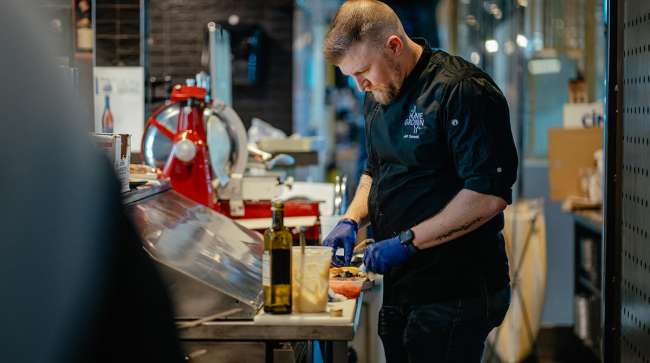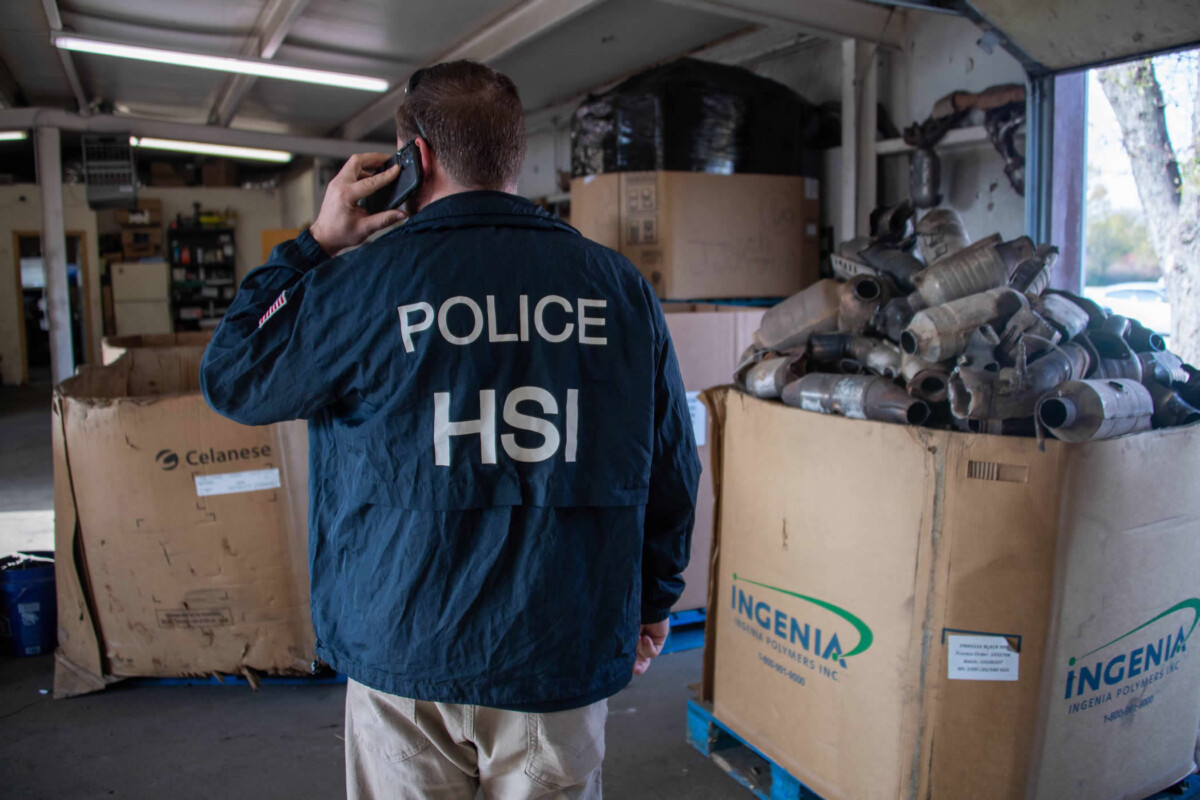Jeff Creswell prepares dishes featuring local ingredients for a tasting at Sysco’s test kitchen in Chicago. (Jamie Kelter Davis/Bloomberg)
On a recent weekday morning in downtown Chicago, chefs inside a test kitchen prepared a five-course meal featuring tostada verde with jalapeño gouda and trout on focaccia.
The chefs usually cook these spreads to help customers of Sysco Corp., the largest U.S. restaurant supplier, create or tweak menu items. These days, they’re also coaching eateries on substitutes for imported ingredients hit by President Donald Trump’s tariffs. That’s why the gouda cheese came from Wisconsin instead of Europe. So, too, did the fish, which might otherwise have been imported from Asia.
Restaurateurs often talk about needing their “magic ingredient” to make their menu items work, said Gabriel Freeman, a Sysco culinary specialist who helped create and cook the test meal. But he said “there’s always alternatives.”
Sysco ranks No. 3 on the Transport Topics Top 100 list of the largest private carriers in North America, and No. 1 among food service carriers.
Sysco is an industry giant and uniquely situated to influence menus. It supplies food to 400,000 establishments in the U.S., where it generates more than 70% of its roughly $80 billion in annual revenue. The company, whose customers include Wendy’s and Chipotle, runs more than 70 test kitchens in the U.S. offering free help for customers. Sourcing more domestic products benefits Sysco, too, by reducing transportation costs and speeding delivery.
The restaurant industry largely sources from the U.S., but some key ingredients are imported. The U.S. relies on Mexican avocados and tomatoes. Almost all bananas come from countries like Guatemala and Ecuador. Up to 75% of seafood is imported. There’s not even enough U.S. beef to meet all the demand. Total agriculture imports topped $200 billion last year.

Sysco supplies food to 400,000 establishments in the U.S. (Sysco)
Trump’s tariffs, which are set to drastically rise in July when a 90-day pause expires, have prompted U.S. restaurants to look for help finding ingredient substitutes to keep a lid on costs. More than 40% of eateries surveyed by researcher Technomic have already shifted some sourcing to the U.S. or countries with cheaper prices.
Minimizing the impact of the trade war has become a crucial move as profits come under increasing pressure, with the National Restaurant Association estimating that it’s 30% more expensive to run eateries now than in 2019. Tariffs would leave businesses no choice but to raise prices given already-tight margins of 3% to 5%, the group has said. Meanwhile, uncertainty around the effect of the duties on prices has prompted many diners to be more judicious about eating out.
In Chicago, Freeman and Jeff Creswell, Sysco’s director of business specialists, are clad in black chef’s coats. They’ve whipped up a charcuterie board featuring Wisconsin gouda made by a Dutch immigrant, duck raised in Indiana and camembert aged near New York’s Finger Lakes.

“Let’s say I have a French person coming in” and the goal is to show them the camembert, Freeman said of the soft, creamy cheese first made in Normandy. “I won’t even tell them in advance that this isn’t from France.”
Freeman recently convinced a Sysco customer who wanted to offer imported cured meats at a new restaurant to use salami from Salumi Chicago, a U.S.-based producer that sources its meats from New York, Iowa, Pennsylvania and Texas.
“It’s not just an alternative,” Freeman said. “This is a great space to highlight how great some of these products could be.”
Many of the products Freeman and Creswell showcased are available through the company’s Home Grown Program, which includes a network of about 30 suppliers within 300 miles of the Chicagoland area. The initiative started around 2019 as “eat local” movements gained momentum. At the time, Trump’s first trade war was also upending food procurement.
Sysco’s push to find more domestic suppliers across its business intensified during the pandemic when global supply chains were disrupted. That effort has ramped up this year as Trump has reignited trade disputes, according to Chief Merchandising Officer Victoria Gutierrez. The firm’s U.S. operations now import less than 10% of its goods.
“We see the strategic benefit in bringing supply chains closer to home because you reduce exposure to disruption,” Gutierrez said, adding that the food is fresher and handled better when it’s sourced nearer to customers.
Sysco has rebounded from the pandemic when restaurants took a hit, but growth has recently slowed. In April, the Houston-based company reduced its sales outlook as consumers cut back on dining out. Its shares are down roughly 6.5% this year, compared to about a 1% decline for the S&P 500 Index.
Robert Brown of Bot Auto breaks down the state of autonomous trucking today, and where it’s headed. Tune in above or by going to RoadSigns.ttnews.com.
Of course, some ingredients don’t have an obvious substitute in the U.S., including many tropical fruits, coffee and cocoa beans for chocolate. Plus, Trump’s vacillation on tariffs has held back Sysco customers from making swaps, according to Scott Ryan, a director of local sales at the company.
Joseph DeFrancesco is part of Sysco’s push to source more domestic goods. His farm near New Haven, Conn., sells about 95% of its crops to Sysco. He’s planning to increase the amount of tomatoes he grows since he expects those imported from Mexico to become more expensive.
Produce from Mexico had tended to be about 25% cheaper than U.S. options, according to DeFrancesco. But with the U.S. planning to impose a 21% duty on Mexican tomatoes in July, he expects demand to rise for his crop.
Tariffs are “going to even up the playing field,” DeFrancesco said.
Fabien Santos, owner of Mexican-inspired restaurant Merkado in San Francisco, scrutinized the eatery’s menu after the U.S. announced tariffs. One solution was to add more tomatoes, white onions and cilantro to the guacamole, so it would require fewer Mexican avocados, and advertise it for $14. The unaltered version with the usual avocado ratio would sell for $17 and be called “tariff-ic guacamole.”
Merkado pulled the plug on the plan once tariffs on many Mexican products were put on hold. But it remains an option if the levies come into effect.
“The blueprint’s already there,” Santos said.
As Trump negotiates over the tariffs, suppliers are leaning into their American cred. At the National Restaurant Association show in Chicago in late May, the booth of pizza maker Palermo’s featured signs that read “made in the USA” and “no tariffs.” The company is opening a 200,000-square-foot facility in its home state of Wisconsin in July that will help serve food-service clients as it expands from the frozen aisle to restaurants.
Bluehouse Salmon advertised “USA raised” fish at the show. The company, which grows salmon in tanks on land in Florida, said that grocery stores have been more receptive since Trump enacted tariffs.
“We’re always calling them — what’s interesting is now they’re picking up the phone,” said Damien Claire, chief sales and marketing officer of parent company Atlantic Sapphire. The uncertainty is making retailers think “maybe I should have a local option.”







